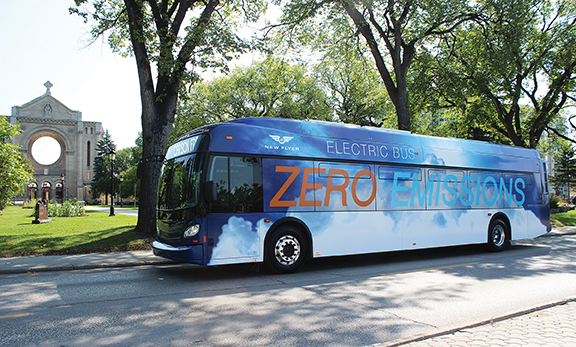
By Steve D. Johnson, Sr.
It wasn’t that long ago when the conversation was about low-emission buses and alternative fuels. We saw an explosion in hybrid bus production followed by the rapid expansion of CNG- (Compressed Natural Gas) powered buses. These were good initiatives, but they can’t meet the goals in place to reduce GHG (Green House Gas) emissions. Zero-emission buses can have a significant impact on reducing Transit’s carbon footprint. California is currently developing a proposal to reduce emissions from transit bus fleets by phasing-in zero emission bus purchases, with the goal of transforming all fleets to zero-emission by 2040. This will be a lengthy transformation, and costly, considering that the zero-emission bus can cost up to two times more than a conventional bus. At the end of 2016, we had just over 300 zero emission buses operating in the United States.
 It’s clear that the drive to zero-emission in transit vehicles has started. So, what does this have to do with the HVAC? A lot, actually. The zero emission bus is powered by batteries, and all of the electrical loads, like the all-electric HVAC, use power from the battery. As on conventional buses, the HVAC is the largest single load on the engine. Now, the load is on the battery and affects how far the bus can go on a single charge. It is easy to understand that reducing the load allows the bus range to improve. But, do we dare turn off the air conditioner? This isn’t likely, but the industry can demand more efficient systems from HVAC suppliers.
It’s clear that the drive to zero-emission in transit vehicles has started. So, what does this have to do with the HVAC? A lot, actually. The zero emission bus is powered by batteries, and all of the electrical loads, like the all-electric HVAC, use power from the battery. As on conventional buses, the HVAC is the largest single load on the engine. Now, the load is on the battery and affects how far the bus can go on a single charge. It is easy to understand that reducing the load allows the bus range to improve. But, do we dare turn off the air conditioner? This isn’t likely, but the industry can demand more efficient systems from HVAC suppliers.
You might be surprised to learn that HVAC suppliers have been driving for more efficient systems for 20 years. On diesel-driven systems, improved HVAC efficiency always meant better fuel economy and a reduction in a number of known pollutants like: carbon dioxide (CO2), carbon monoxide (CO), volatile organic compounds (VOCs), nitrogen oxides (NOx), sulfur oxides (SOx), and particulate matter (PM). The concept is not new, but the approach to improved HVAC efficiency has changed with all-electric systems.
DEFINING EFFICIENCY: In layman’s terms, the amount of power input in kilowatts (Kw) versus the amount of power being used to achieve a defined output (Kw) determines efficiency. If the output of the HVAC system needs to be 18 Kw, how many Kw is required to achieve that output? The method that requires the least input to get the desired output is the most efficient.

STRATEGIES TO IMPROVE HVAC EFFICIENCY: The bus battery will only have so many kilowatt hours to use before recharging is necessary, so applying the loads in the most efficient manner possible can have great affect. Here are some of the approaches being implemented.
1. Variable frequency control for the electric compressors, up to 75Hz for pull down and variable down to 45Hz, or three (3) stage unloading of electric compressors and variable frequency to control fan and blower speeds. This power control strategy allows the system to use power only when it’s needed. Liken it to the power saver mode on your home appliances.
2. A programmable and configurable microprocessor capable of reading pressure and temperature transducers, controlling frequency and making decisions to adjust the loads based on the demand for cooling. Also, it should have the ability to communicate with the other on-board systems, so intelligent decisions like adjusting the thermostat set point can be made.
3. Build a better bus. Does the amount of insulation in your house have an effect on how large your air conditioning bill is? You bet it does. Improvements in insulation and glass transmittance can reduce the demand for cooling by as much as 20 percent. It also means that systems can be smaller and weigh less. Weight matters.
We can’t end this discussion without talking about heat. When we used engines, we had enough free heat to satisfy all but the coldest climates. With the zero-emission bus the heat must come from an electric power source with a huge kilowatt draw off the battery. In colder climates, this can be as much as twice the power needed for the HVAC in a hot climate. One option is to turn the HVAC into a heat pump, but it will only operate down to about 20 degrees Fahrenheit. This is good for seasonal use and milder climates. Electric heat is still needed for some applications. Other strategies are being tried, and there is no doubt that the industry will come up with viable solutions. After all, I live in Minneapolis –and we must have our heat.
Steve D. Johnson, Sr. serves as product marketing manager, Bus HVAC, at Thermo King, Minneapolis, MN. Thermo King is a world leader in transport temperature control systems for buses. Thermo King also manufactures auxiliary power units, which dramatically reduce engine idling. All Thermo King products are backed by a nationwide dealer network.
